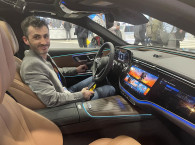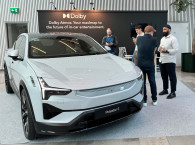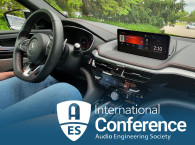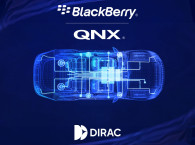There was a renewed energy at CES 2024. It was noticeable in the streets, the LVCC Halls, the Venetian Suites and Expo, and all the hotel rooms and suites still used by audio companies. The streets were filled with an additional 135,000+ people across four intense days. That official registered number likely falls short of the unofficial attendance, but that nevertheless still is a record figure for the adrenaline-fueled excitement that stands out among the usual activities of the leisure crowd in Las Vegas, NV.
The Consumer Electronics Show has become a showcase of products of the future, and this year’s content was stronger than ever. In fact, the automotive sector in the West Hall was filled beyond capacity, with Mobility spilling over into the North Hall.

With supply issues behind us, used vehicle prices normalized, and supply built back up to expected levels, the automotive industry has fully recovered, albeit in a world of limited demand. In the US, Cox Automotive estimates that 2024 will see USD 15.6 million in new car sales, a 2% growth over last year. That is the most normal level of sales in the last five years. It is also estimated that EV sales will increase to become 10% of the US market, stemming from more production output of EVs.
Even with all the positive energy that abounds in the automotive industry and the exciting vibe that existed at CES, it was possible to come away with more dissonant feelings than in the past year. A feeling rooted in the real shift from hardware-dependent development in automotive to software-dependent development. Artificial Intelligence has found a practical role, and the idea of a Software Defined Vehicle has become mature with application - and yet we have found unique ways to integrate hardware into our audio systems.
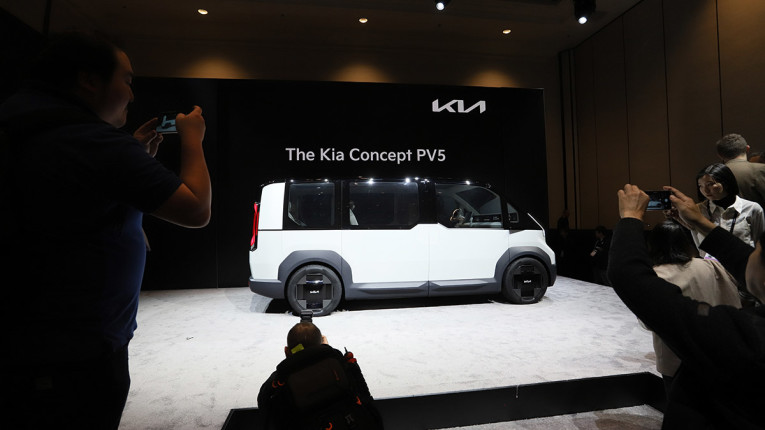
The Role of AI in Automotive
Upon entering CES 2024 in Las Vegas this past January, it was clear that gone are the sky-high commitments and the lightspeed timelines given for promising new technologies, including AI. High interest rates, tighter capital access, and a growing impatience from investors and customers have changed things. Expectations for automotive AI have come back down to less rarefied air.
Most companies at CES showcased automotive AI in lower-stakes applications, such as vehicle personalization, rather than in complex functions such as autonomous navigation on busy city streets. The aspirational aspects of products have become more mature and ready for prime time: practicality, less flashiness, and creating greater efficiency in decision-making are the goals of automotive AI.
Rather than having engineers manually code responses to individual stimuli and edge cases, vehicles may learn from examples, like humans do, performing tasks better, rather than striving for perfection. Ethan Mollick, an associate professor at the Wharton School of the University of Pennsylvania, wrote in an article for the Harvard Business Review in December 2022, shortly after the release of ChatGPT, that “Until now, AI has primarily been aimed at problems where failure is expensive, not at tasks where occasional failure is cheap and acceptable.”
Chatbots, ChatGPT, and other lower-stakes AI tools were fertile ground for the automotive industry at CES this year. There was a lot that was centered around voice assistants, personalization of the in-vehicle experience, and a little on the digital customer experience. Automakers were delivering on the low-hanging fruit. Displays included internal AI tools that help engineers write code and streamline processes, such as research and design, that are invisible to the consumer. Customer service bots, driver and interior monitoring, as well as tools to predict maintenance and repair needs are the new frontier.
Automotive companies and their suppliers are increasingly trying to develop technology that takes advantage of multimodal AI, which enables the developer to provide multiple types and modes of data, and then generate an output for each of them. It is technology that can generate text, audio, and video, while monitoring tire pressure, climate control, and other vehicle features. All of this is part of an industry drive to make vehicles as personalized as possible – to which the audio system will be central.
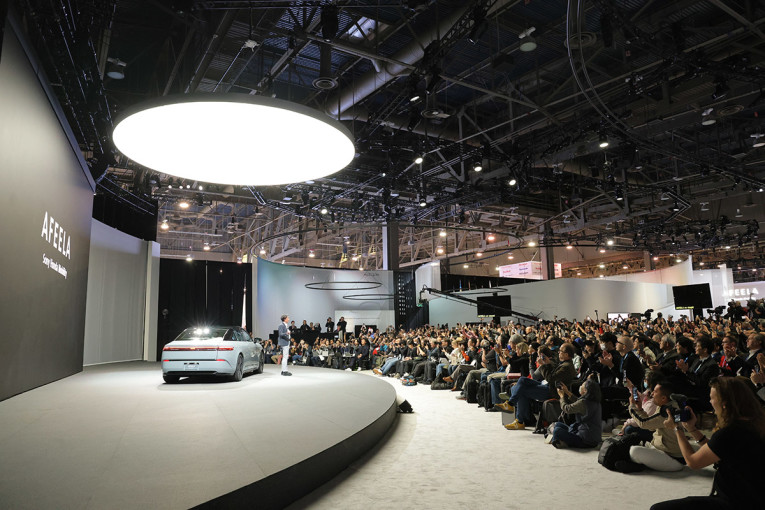
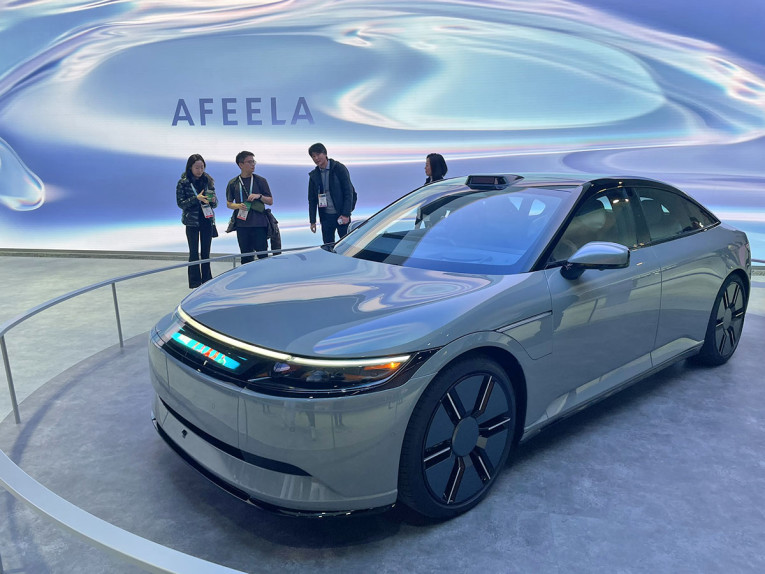
Software-Defined Vehicles
The Software-Defined Vehicle (SDV) has been an industry buzzword for a few years now, but it seems to be on the verge of breaking through with real applications. Compared with last year, Qualcomm refocused its approach to automotive this time and talked about its Hexo-Software Factory, rather than new chipsets.
We are in a period of rapid change. In 2021, just 2.4% of vehicles on the road could be described as software-defined (mainly Tesla models), according to data from Deloitte. By 2030, "90% or more" will fit that definition. Automakers hope that shifting emphasis from hardware to software will cut development costs, strengthen customer loyalty, and increase revenue. However, creating a smartphone-on-wheels requires a complete rethink of vehicle development, new supplier relationships, and an overhaul of corporate culture.
What counts as a "true" SDV is up for debate, but most agree it needs to have a centralized computer system with just a handful of powerful ECUs controlling a range of on-board functions as well as data flow to and from the cloud.
Because the focus now is getting the latest and best software experience, features, and user experience, what used to be a software selection based on the hardware in use is now reversed, as the hardware is dictated by the software. This starts with a future vision, and then the idea of what is needed to achieve this. Following this, then, is the development of a chip, hardware, or the electronic/electric (E/E) architecture, to use the topology of the automakers. That is a reversal of the traditional model. It’s not only about the chips and the hardware, but also about how the software is developed.
"The promise of the software-defined vehicle is going the same way as the promise of autonomous vehicles. It is difficult," said Jean-Marie Lapeyre, Capgemini's chief technology and innovation officer covering automotive. Lapeyre's experience in IT and Information Security goes back many years, having worked for GM, Opel, and PSA Group.

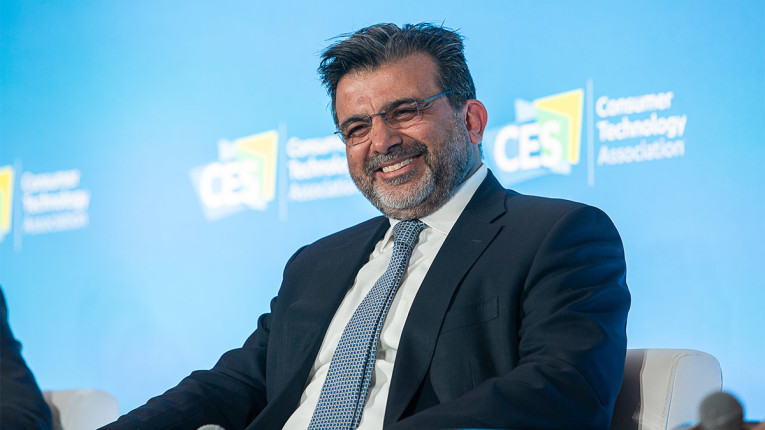
Bill Pinnell, Vice President and head of Automotive Software Product Management at Qualcomm, talked about the company’s Hexo-Software Factory solution to this problem at CES 2024, starting with a challenge and ending with what he felt was a mature solution. The challenge is that there are tens or hundreds of millions of lines of code in a vehicle. When such a level of software needs to be updated, and the latest version of Apple or Android needs to be added – or whatever it is that the consumer and the OEM want to do – then a different software design and development methodology is also needed.
In other industries, particularly in Cloud, this is nothing new. So, what we call Cloud-native development – cloud-development people writing code that runs in the cloud – that refers to micro-services, or service-oriented architecture (SOA). These are very well-established principles, and now we're seeing their appearance in the automotive industry. The algorithms for automotive audio play into this directly, which is why Harman and Bose are not hardware-focused, but rather software-focused, and why Dirac and others are looking for a place on platforms like Blackberry QNX and DSPC Audio Weaver.
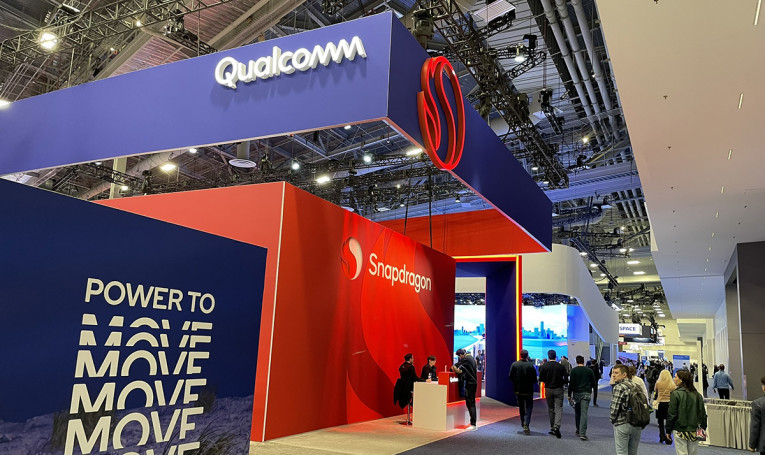

Progress Is Being Made
Most automakers have now combined the driver display with the central touch screen in a sort of predecessor to the zonal computer architecture to create a coherent infotainment system with over-the-air updates and additional downloadable features. But as is the case with most tech developments in the automotive industry, Tesla is leading the race to create the software-defined vehicle. Chinese startups such as Nio are not far behind, similarly unconstrained by a legacy development culture.
"Our ambition is to become a software-defined company," said Derek de Bono, vice president, software-defined vehicles at Valeo. "Not to the detriment of hardware, but the software will define what hardware we need and what we can do with it,” he said at CES this year. "You can design your product, partner with any kind of player, then start right away."
The risk of making sweeping software changes within an established automaker is even greater. Starting production on time is hard enough without having to chase down bugs in a new E/E architecture that is running new software from suppliers with whom the automaker has never worked. If everything is done at once, development is overloaded, potentially putting the entire schedule at risk. However, those schedules are being upended because automakers know they must take the risk if they want to transform the car into a smart device that offers seamless updates, services, and data-driven intelligence. With the current architecture, it is not easy to implement the services everybody dreams about. It requires a system with a central computer, itself another sweeping change.
The industry needs to move away from "value chain" and toward "value network," Christian Sobottka, president of automotive for Harman, said at CES this year. "There was a period when certain automakers were trying to apply the old industry model to the new challenge. Over the last two years, some of them have struggled and failed." A cultural transformation is required. "The cooperation model of the past where the automaker defined everything and commanded a certain set of suppliers is not good to lead us into the future. There is a huge partnership needed," added Sobottka, formerly CTO at supplier Robert Bosch.

The difficulty lies in the creation and combination of all the software elements. The car needs not only to act as a self-contained edge computer, but also to connect to the cloud to receive updates and feed all the app-driven services. All sensors need to be connected to the centralized computer, while operating with total security. "Technically, it's not rocket science, because other areas have done it, but the change toward a very modern, consistent software architecture is costly, painful, and intense," Sobottka continued. Providing a common language was something the smartphone industry solved over time by coalescing around two operating systems: Apple for its own phones and Android for pretty much everything else. The car industry is not there yet.
The Software-Defined Vehicle Alliance was launched at CES 2024 this year to push for a "commonization" of standards and development methodologies. The idea is that anything developed in terms of software will then easily communicate with the middle and base layers of software in the car, allowing new code to be written and tested in the cloud (known as the "digital twin" method). This would theoretically cut months from model development time and save millions by avoiding "hardware-in-loop" bench-testing in prototype vehicles.
The industry groups were set up out of frustration, seeing the automakers as being stuck in their ways and unable to move. For example, the British chip and software designer Arm created SOAFEE (Scalable Open Architecture for Embedded Edge) in 2022 to give the SDV industry a much-needed push. SOAFEE's members include Continental, Tata Motors, Geely, Qualcomm, and Harman. In this new supplier relationship, automakers can focus on the software the customer sees, allowing for brand differentiation. Suppliers, meanwhile, can work on the layers below, allowing them to create scale by reusing software. Independent app developers can work on car-specific services with the knowledge that they will be compatible with a range of brands because of a common "abstraction layer," where instructions can be passed without needing to know the details behind them. APIs can be the software mechanism for accessing the features of a given platform.
Automakers are leaning heavily on chipmakers such as Qualcomm, Nvidia, and Renesas to supply centralized systems-on-chips (SoCs) powerful enough to deal with the increased screens, enhanced graphics, and additional data processing needed. Much like many hardware companies, hoping to get into the automotive industry and sell their new designs, found that it was easier to partner or merge with an existing hardware company. Likewise, chipmakers who are new to automotive discovered it was easier not to compete with existing frameworks, and instead to create the platform for the frameworks to sit on.
Although tech companies are pushing their way into a space almost exclusively occupied by traditional automotive suppliers, several established players are also winning substantial business. Harman last year won what Sobottka described as the company's largest automotive order ever for a centralized computing system for a single company worth "multi-billion dollars." He did not name the company. Mobileye last year booked orders of USD 7.4 billion. The former Israeli startup, now owned by Intel, has shifted strategy from offering a "black box" ADAS product to letting automakers tune the final product via its DXP operating system.
Whether a return on the investment pouring into SDVs will be seen remains an open question, as suppliers and automakers investigate which content and services customers will be willing to pay extra for. What won't necessarily work, for example, is asking customers to pay to unlock embedded hardware, a problem that BMW ran into recently after promising to drop its idea of a heated-seat subscription. The concept of the "App Store" for automotive features is something that is appealing for automakers but is not easy for consumers.
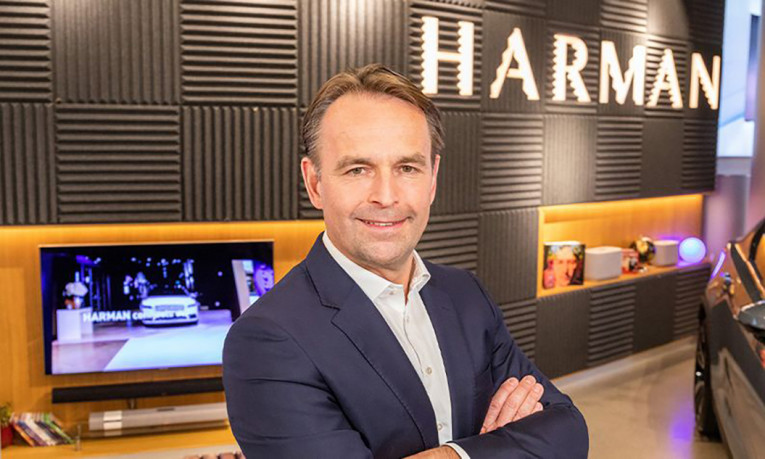
Consumers would gladly accept the idea if it meant making the car cheaper and allowing them to pay only for things they want or need. But consumers are also suspicious and tend to believe they are being primed for upselling. Automakers have seen the value of selling audio and video streaming, but even after experiencing a compelling audio demonstration in a car, consumers might find it hard to pay extra for abstract things like algorithms. It will be in the hands of the audio brands to make it compelling and in the hands of the automakers to keep the consumer aware and interested in the something new that comes along.
There is also the issue of regional regulations and taxes. Where will the “App Store” reside, in a tax-haven cloud? Do consumers pay VAT for these apps in addition to the local sales tax? This is a similar issue for buying a car in the European Union. For example, the same car purchased in Germany might cost twice as much in another EU country whose GDP is a fraction of Germany's. The result of local special taxes and higher VAT, which is in addition to the tax on the car.
Similar regional issues exist for streaming, not only for availability, but for data security. One automaker that uses Google as its OS, ran into a problem with at least one prominent Middle East country that would not allow any data from its home country to be transferred to a server located outside the country. A solution was eventually found, but it was not the impossible swapping of hardware, it was working with Google to rewrite the code that was used in that country, so the data was isolated to the local Google servers. The joy carmakers might have in the prospect of “reselling” the same car with a software update in year or two is complicated by not being able to sell the “same” car everywhere.
Yet, the drive for Software-Defined Vehicles is strong, and it will have an impact on how audio features are delivered to vehicles and how they are developed. "The constant is that you need more computing power. There's a direct link between the amount of compute in the car and how safe that car can be," and how many additional features can be provided, Danny Shapiro, head of automotive at Nvidia, told the software-defined vehicle panel at CES 2024.
Future-proofing a car with oversized chips is a possibility, but the desire to improve E/E architectures with the latest equipment for subsequent models will erase some of the cost-saving from repeatability. "Nothing lasts forever," Fisker CEO Henrik Fisker mentioned. "If that was the case, you would still be running around with your first iPhone." The improvements in ADAS and the potential for downloadable, hands-free driving as promising revenue streams will drive a computer power race.
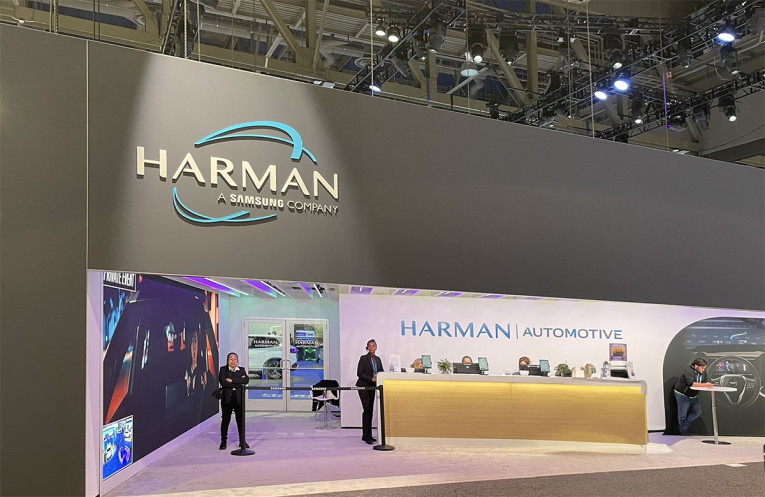
Automotive audio will be going along for the ride in the computer power race. Audio software platforms, such as Blackberry QNX and DSP Concepts' Audio Weaver will be integral in providing the audio solution to a Software-Defined Vehicle. Chipmakers, such as Qualcomm, Analog Devices, NXP, and Texas Instruments, are still where low latency requirements will be met, and the platform will enable the software, like ANC and Immersive Audio, to work on the chip level and then communicate up to the system level. Those platforms will find their comfortable space in the larger software framework with which they will be collaborating, even if it is Apple or Google in the end.
However vast the problems in creating the software-defined vehicle are, and whatever the consumer's real desire for the products may be, the race to solve them is becoming more intense as Tesla and several Chinese startups work through the same issues without the drag of legacy cultures. Right now, automakers are racing to catch up with these newer players.
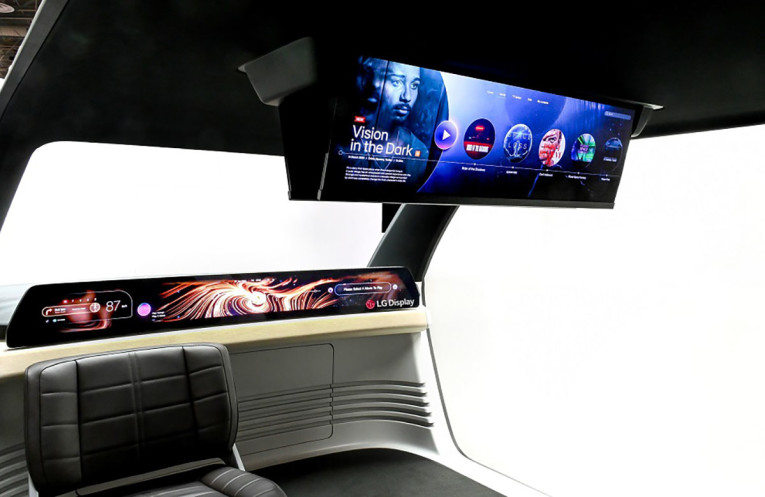
Integrations
Also available at CES 2024 were product-based achievements for seamlessly incorporating audio in seats, trim, and other boundaries in the car. And a unique method of applying some high-power acoustic compression ideas to low-power low-frequency driver design.
Sonified by Trèves is taking the integration of audio hardware further in a new direction and, with the support of a Dirac OPTEO tuning, it was demonstrated under the Audio Foundry’s tent in the Central Plaza. Trèves is an automotive supplier of interiors and acoustic treatment, specializing in recycled textiles for automotive.
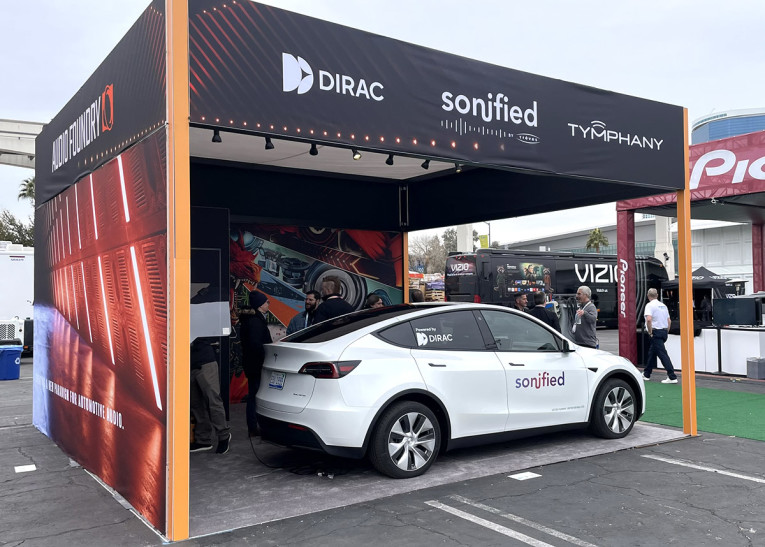
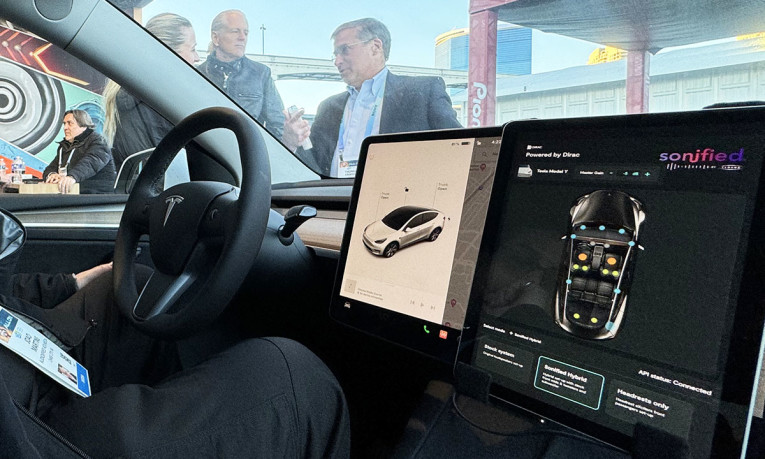
Unlike the typical application of exciters to rigid door or dash panels, which over time can develop buzz, squeak, or rattle problems, Sonified selects a panel of precisely the desired size and shape, attaching a transducer to it, and then suspending it in the foam underlayment of a carpet or a headrest. The air captured in the individual cells of the foam provide the equivalent of a larger space. That material is a polyurethane-covered honeycomb material like that used in package shelves.
The Sonified system was demonstrated in a Tesla Model Y that retained its complete stock audio system for comparison. The Sonified system used the Tesla's three midrange and two tweeters but turned off the door speakers in favor of two of these panel speakers placed behind carpet on the sides of the center console. The subwoofer in the cargo area was replaced by two subwoofers in the carpet under the front seats. And two Sonified speakers were mounted in each front headrest as well. These were able to reproduce sound from 60Hz to 12kHz. This also has an advantage in ANC or Personal Sound Zones.
Dirac OPTEO tuning will be paired with the all-new Trèves Sonified technology to showcase a future of automotive audio where smaller, lighter, and more strategically positioned speaker systems can produce increasingly high-quality sound.
The Dirac OPTEO tuning featured patented multiple-input/multiple-output (MIMO) mixed phase impulse response correction technology, addressing the acoustic challenges common in cars by enabling all speakers to work intelligently together and co-correct each other’s impulse response.
The combination of Dirac OPTEO and Sonified’s system design enables superior sound from a speaker system that’s lighter in weight and more strategically placed – which is increasingly critical for electric vehicles whose battery efficiency is largely dependent on vehicle weight.
Flexound Augmented Audio also had an integrated seat sound solution at CES. After improving cinema experience in commercial and home theaters, it took the technology and applied it to automotive seating - soon to be launching with a Korean OEM automaker. Their construction is two shakers integrated in the headrest, which also couples to the seating frame to generate a full audio band experience, which can also be tuned below 20Hz.
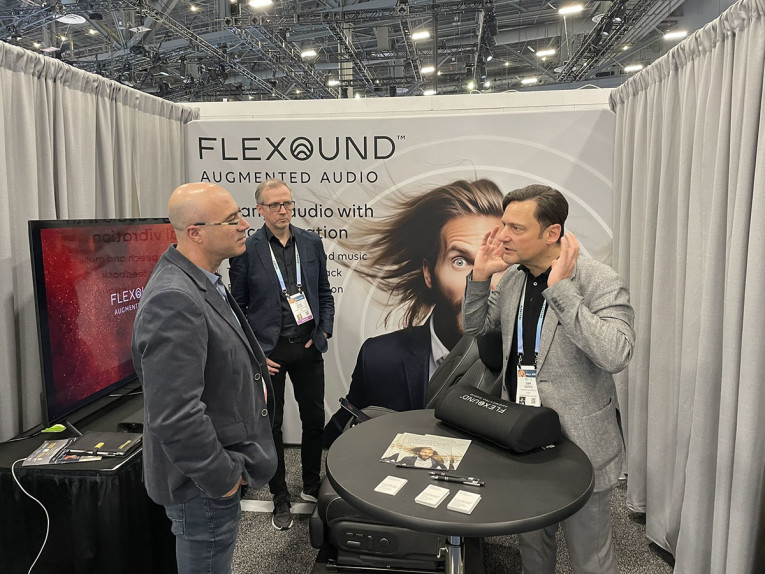
They demonstrated the clarity of sound using multi-sensory listening. There was a clear improvement in speech and music perception and phone call quality. Full frequency range with only one element, which can also produce stereo output. It too would enable ANC solutions with both sound and vibration.
LG Electronics unveiled a transparent antenna for automobiles at CES 2024. The thin film broad-surface application is designed for compatibility with various types of glass and vehicle designs. R&D has begun on using the thin film for reproducing information cues, not broadband audio, for the passengers and driver.
At its dedicated booth for automotive displays in the West Hall of LVCC, LG Display showcased a series of ultra-large automotive display solutions, including the world’s largest automotive display - the 57" Pillar-to-Pillar (P2P) P-OLED, and the largest slidable panel, the 32" Slidable OLED. These displays are an extension of LG's vision for each stage of the development of Software Defined Vehicles: Shift, Evolution, and Beyond. The crucial “screenification” of SDVs - which LG describes as "a big smartphone-on-wheels" - is seen as strategic to enable drivers and passengers to control a multitude of functions.
To help achieve perfect harmony between the display and the cabin, a new “Decorative Film” is attached to the screen to resemble interior materials used in vehicles, such as carbon or wood, when not in use. In addition, LG's proprietary Thin Actuator Sound Solution presented last year, and which is just 30% of the weight and 10% of the thickness of a conventional car speaker, can be installed in various parts inside the vehicle, such as the display, ceiling, and floor, to produce an immersive sound experience.
This article was originally published in The Audio Voice newsletter, (#458), February 22, 2024.



